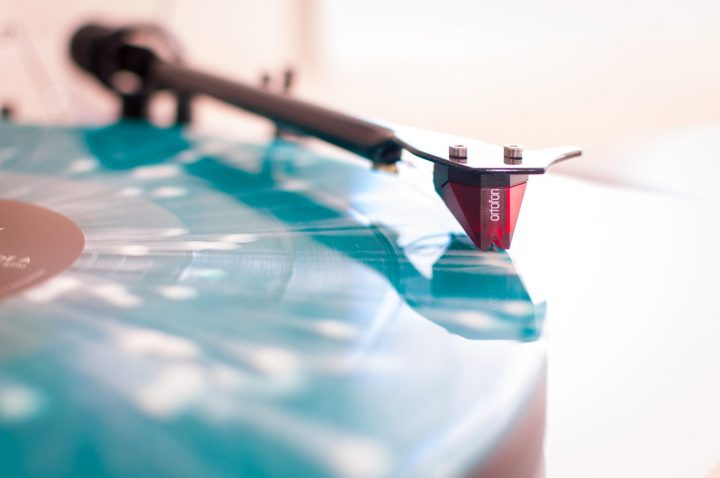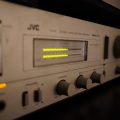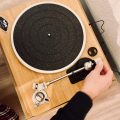What is that rod that juts out of a turntable from nowhere? Why, that is the record player tonearm! Well, what does it do? And how does it do it?
Step right up as we explore everything you need to know about record player tonearms condensed into one neat package.

What is a Tonearm? What Does it Do?
Chief among our investigations into the record player tonearm today is, surely, getting to know precisely what a tonearm is and what it is actually for in the first place.
In essence, a tonearm is the part of a turntable that is designed to support the phono cartridge in its journey to exploring the record grooves of vinyl records. Seeing as the cartridge holds the stylus, this is clearly a big deal and one of the essential parts of the turntable’s ability to turn this vibrational data into sound.
In fact, it is the stylus that is one of the only parts of the turntable that actually comes into contact with a record, along with, of course, the turntable platter. Of course, the platter might well be sheathed with a slipmat, in which case the cartridge and stylus will very well be the only parts touching a record.
Most cartridges are designed in such a way that they attach to a headshell or another similar kind of connector that allows the tonearm to support the cartridge as it makes its way to the center of the record. In this way, the height and angle that the arm tube is set to are of the utmost importance.
If, for example, a cartridge is set in such a way that adds too much weight to one side of the tonearm, then a counterweight will be needed, lest you do some serious damage. Refusing to counter the weight and engage in such a balancing act will likely lead to you doing damage to your records, essentially burning your hard-earned cash right before your eyes.
In the short term, too, this can have disastrous effects on the sound quality of the resulting sound.
Designs & Shapes
There is a number of different designs and shapes of the tonearm on the ever-swollen burgeoning turntable market today, though they can, more or less, be divided into three distinct categories:
Straight Tonearm
Such a tonearm is rather common, especially when it comes to the kinds of turntables that are mass-produced for the consumer acoustical systems market.
There are options within this category pertaining more to size, which rely heavily on anti-skate mechanisms within the turntable to function properly. They are inherently designed to counteract the inward friction that the process of spinning records creates for the needle and such.
There are, however, more stable options that are shorter. These, needless to say, do not require an anti-skate mechanism anywhere near as much (if at all). This results in a more optimal playback as there is less chance of external vibrations causing a ruckus.
J-Shaped
This kind of tonearm is altogether rather similar to a straight tonearm, the one notable difference being that the headshell at the end of the tonearm juts to the left a little. This is how the tonearm gets its name.
The single point of such an invention is simply to allow a longer tonearm to fit into the same space that a straight tonearm would without any inherent tracking errors.
S-Shaped
The S-shaped tonearm is, as you have probably guessed, shaped like the letter S. This innovation ensures that any vibrations in the chassis are eliminated before they can interfere with record players offering the best sound for the audio experience.
In terms of the design itself, there is a fulcrum point in the very middle of the tonearm that provides a resting point for better azimuth and overall stability. The idea is that the azimuth helps to keep the cartridge and needle in the center of the groove, ensuring that both sides of the stereo field are kept safe against any of the inherent driftings that can sometimes occur.
Materials
Just as certain woods can affect the sound of, say, a musical instrument, the material from which a tonearm is constructed is said to have an enormous bearing on the resulting sound. Bear in mind that those who say so are usually audiophiles with little else to do with their time.
Indeed, there are plenty of audiophiles that will have you believe that the wood from which a tonearm is constructed is a complete and utter deal breaker when it comes to the resulting sound of a turntable. The higher the quality of the materials from which a tonearm is constructed, the better the audio experience is said to be after the fact.
The primary materials that help with the sound quality are located in the tubes of the tonearm themselves. These are more often than not made from metals like aluminum, titanium, or steel, though there are some more high-end models that are made from wood or carbon fiber that are, supposedly, better for the tonal response overall.
These materials are essentially acting as a buffer to reduce the impact of the turntable plate and the resulting vibrations on the cartridge, to ensure that these vibrations are as deflected as possible.
It is believed that when wood is used, if it is harder then it is usually better for the overall acoustic performance. Of course, any wood will need a surface treatment of some sort to ensure the best sound quality, after which vibrations are greatly reduced. Wood is generally favored by many audiophiles who believe it also performs well at balancing the tonearm properly.
Resonance & Distortion
Another thing to bear in mind with regard to tonearms is the resonance and distortion that might occur along the way.
The resonance of a tonearm is the specific frequency that inherently occurs from the interaction between the tonearm and the cartridge. The behavior of the cartridge – its compliance with the pressure and its relative springiness – will differ depending on the various individual parts that you are using.
The springiness itself allows the cartridge to move along the grooves while also being still enough to allow the cantilever to move enough to produce sound. If this all sounds a little confusing, do not fear. It is an objectively difficult process, but thankfully it is the components themselves that have to do most of the thinking and leg work.
In this way, the resonance frequency can be thought of as the amount of force that the needle needs to move the tonearm. Amplitude itself results from the tonearm dampening, a feat achieved with either silicon fluid or magnets. Again, this is perhaps more complicated than you need to know, but it can also help to be more aware of these things should something in your turntable stop working.
One day, you might, for example, find that your record player sounds distorted. There are plenty of reasons why this might be the case, though there is one specifically that links to the action of the tonearm.
This is commonly referred to as inner-groove distortion, the deterioration of the sound that is heard at the end of a record. This is more obvious when listening to music at higher volumes when a record player is connected to a phono preamp via an RCA cable.
To remedy this, some songs have been known to be produced at a lower volume towards the end of the song to prevent this kind of distortion from occurring.
Final Tones
So, there you have it! Hopefully, this short study into record player tonearms has been of some use to you.
FAQs Record Player Tonearm
What is the tonearm on a record player?
On a record player, the tonearm is part of the turntable, one whose functions are several. Arguably most important is the fact that at the end of the tonearm is the cartridge and, at the end of the cartridge, the stylus. This stylus is one of the only parts of a stereo system that actually comes into contact with the record itself. Thus, it should not be hard to see how it is of the utmost importance. The signals from this stylus are transmitted through the cartridge and then through the tonearm to the preamp via wiring within the tonearm itself.
What is the function of a tonearm?
The tonearm has a number of functions, though most importantly, it is the shaft upon which, at the tip, sits the cartridge. The stylus within this cartridge is the part of a turntable that actually reads the sensitive data pressed within the record’s grooves. This data is read and then sent through the cartridge and the tonearm via wiring, after which it will be sent to a preamp and then, eventually, a dedicated amplifier before finally being sent forth through some headphones or a set of stereo speakers.
Does tonearm affect sound?
There are plenty of audiophiles that would have you think so. Many, in fact, will plead that the material from which a tonearm is constructed has a very significant bearing on the resulting sound. Now, the material no doubt has something of an impact on the overall sound quality, though it is unlikely that it is as much of a big deal as such audiophiles would have you believe. Perhaps more important is the shape of the tonearm or the cartridge that is sat upon the tip of the tonearm.





